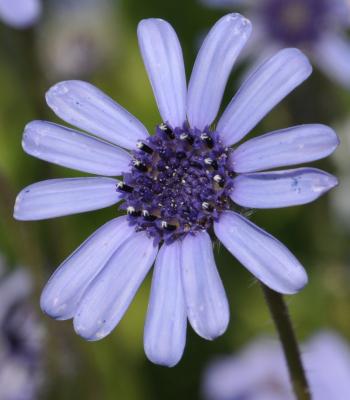Felicia heterophylla
Felicia heterophylla (Cass.) Grau
Family: Asteraceae
Common names: true-blue daisy (Eng.); bloublomastertjie (Afr.)
Introduction
The true blue daisy is one of the few felicias with entirely blue daisy flowers, in contrast to the others with yellow centres surrounded by blue/purple or white 'petals'. This pretty bushy annual is one of the spring flowers of the Western Cape.
Description
Description
Felicia heterophylla is an annual herb of 0.3 x 0.3 m. The oblanceolate leaves are arranged alternately on the stem, 10-50 mm long, hairy, sometimes with 3 main nerves in the broader leaves. The margins are smooth or rarely obscurely toothed.

The blue flowerheads, consisting of blue ray and disc florets, are borne singly on long peduncles during spring (August-October). The 'seeds' (cypselas) are small, 4.5 x 2 mm, elliptic or obovate, yellowish brown and hairy. They are topped with a tuft of white hairs (pappus hairs) which helps with wind dispersal.

Conservation Status
Status
Felicia heterophylla is not threatened.
Distribution and habitat
Distribution description
Felicia heterophylla is a Cape endemic, occurring naturally in the Western Cape from Clanwilliam to Cape Town. It is usually found on sandy flats and slopes.

Derivation of name and historical aspects
History
It is unclear why the specific epithet of heterophylla, meaning different leaves, was chosen for this species. Some of the leaves can be broader than the others and then have 3 main veins, and the leaf margins of some leaves are toothed. This might have given rise to the description of a difference in the leaves, but it is not always clear in every specimen.

Growing Felicia heterophylla
Grow
Plant Felicia heterophylla in full sun so that the flowers can open to their full potential. It is fast-growing, half-hardy, and needs moderate water. Mass plants for a splash of blue or mix them with white and yellow Namaqualand daisies (Dimorphotheca pluvialis and D. sinuata) for some Namaqualand splendour in your own garden! Use as an edging plant along an informal border. This plant is ideal as a temporary filler for any bare, sunny area.
Propagate from seed sown in late summer to early autumn (early March in the southern hemisphere). Seed is best sown in a seed bed or seedtray and seedlings transplanted to a sheltered position in the garden whilst they are still fairly small. Germination takes place within one week.
These plants come from a winter rainfall area, so you will need to water if your garden does not receive rain at this time. The plants prefer light, well-drained soil enriched with compost.
In areas with very cold winters, seeds can be sown in seedtrays in a glasshouse and the young plants transferred to the garden when the weather warms in early summer.
Other felicias you might like to try in your garden include Felicia dubia, Felicia echinata and Felicia elongata. Newly described Felicia josephinae may also become available.
References
- Goldblatt, P. & Manning,,J. 2000. Cape Plants. Strelitzia 9. NBI,. Pretoria.
- Grau, J. 1973. Revision der Gattung Felicia (Asteraceae). Mitteilungen der Botanischen Staatssammlung, München 9: 558-560.
- Herman, P.P.J. & Joffe, P. 2003. Brighten your garden with South African daisies. Poster presented at the First International Meeting of DEEP ACHENE: The Compositae Alliance, January 2003, Pretoria.
- Joffe, P. 1993. The gardener's guide to South African plants. Tafelberg, Cape Town.
Credits
P.P.J. Herman
National Herbarium, Pretoria
January 2004
With additions by Yvonne Reynolds
Plant Attributes:
Plant Type: Bi/Annual
SA Distribution: Western Cape
Soil type: Sandy, Clay, Loam
Flowering season: Spring, Winter
PH: Acid, Alkaline, Neutral
Flower colour: Blue
Aspect: Full Sun
Gardening skill: Easy
Special Features:
Horticultural zones












Rate this article
Article well written and informative
Rate this plant
Is this an interesting plant?
Login to add your Comment
Back to topNot registered yet? Click here to register.